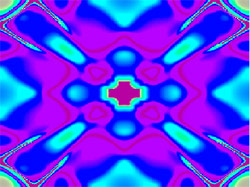An international research team has discovered that a magnetic field can interact with the electrons in a superconductor in ways never before observed. Andrea D. Bianchi, the lead researcher from the Université de Montréal, explains in the January 11 edition of the journal Science what he discovered in an exceptional compound of metals -- a combination of cobalt, indium and a rare earth -- that loses its resistance when cooled to just a couple of degrees above absolute zero.
Superconductivity is a phenomenon which occurs in certain materials and which manifests itself by a complete loss of electrical resistance. An important area in the study of superconductors is how they respond to magnetic fields. Besides their obvious relevance to practical applications, such studies are an ideal way to obtain a deeper understanding of the fundamental aspects of superconductivity.
When subjected to a magnetic field, most superconductors will generate vortices (electric tornadoes) which confine them in tubes of magnetic flux. Such vortices have been described by a model for which Alexei Abrikosov and Vitaly Ginsburg received a Nobel Prize in 2003. However, the results obtained by Eskildsen and his colleagues reveal a radical departure from the usual behavior.
“Even in materials such as the high-temperature or heavy-fermion superconductors, where we do not presently understand the microscopic nature of the superconducting state, the Abrikosov-Ginzburg-Landau picture has, for more than 50 years, provided us with a phenomenological description of the vortices,” Eskildsen said. “But in CeCoIn5, as our measurements demonstrate, this paradigm breaks down, forcing us to rethink our understanding of superconductivity.”
The discovery of superconductivity in certain ceramic materials at temperatures as high as 140K (-208 degrees Fahrenheit), well above the boiling point of liquid nitrogen, opened up new possibilities for applications. Superconductors are currently being used or developed for a wide range of applications including electric power transmission, ship propulsion motors, magnetically levitated trains, magnets for medical imaging, and digital filters for high-speed communications.
"This discovery sharpens our understanding of what, literally, holds the world together and brings physicists one step closer to getting a grip on superconductivity at high temperatures. Until now, physicists were going around in circles, so this discovery will help to drive new understanding," said Prof. Bianchi, who was recruited to UdeM as a Canada Research Chair in Novel Materials for Spintronics last fall and performed his experiments at the Paul Scherrer Institute in Switzerland, in collaboration with scientists from ETH Zurich, the University of Notre Dame, the University of Birmingham, U.K., the Los Alamos National Laboratory and the Brookhaven National Laboratory.

